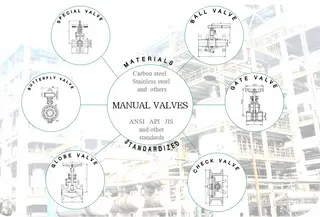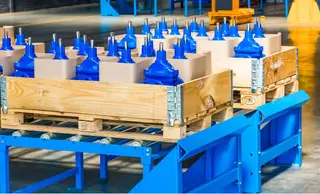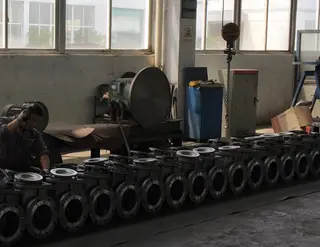The Manufacturing Process of Industrial Valves

Ever wonder how industrial valves are made? The pipe system is not complete without valves. Since safety and service lifespan are the top concerns in a pipeline process, it is crucial for valve manufacturers to deliver high-quality valves.
What is the secret behind high functioning valves? What makes them better in performance? Is it the material? Do the calibration machines matter that much? The truth is that all of these matters. Before understanding the minute details of the industrial valve, one needs to know more about how valves are made.
This article will discuss the manufacturing process of industrial valves from beginning to end. That would make readers better understand industrial valves.
1. Order and Design
First, a customer places an order of the valve that is a customized valve or valve found in the list of already-available valve designs. In the case of a customized one, the company shows a design to the customer. Once the design is approved by the latter, the order is generated. The customer also provides a reservation deposit to the company.
2. Inventory
Once the orders are generated and the design begins, the manufacturing department will look for the raw materials for the stem, spool, body, and bonnet. If there are insufficient materials, the manufacturing department will procure these materials from suppliers.
3. Completing the Checklist
Once the materials are all present, the manufacturing team goes over the list again to ensure that everything is complete. It is also at this time that approval for the final draft of the design happens. Additionally, the quality assurance team checks the materials thoroughly, which is to ensure that the raw materials are of the best quality.
4. Production Process

This encompasses the majority of the manufacturing process of industrial valves. Each major components are made individually. Often, there is a checklist that entails all the names of the spare parts and what material to use for each.
It is at this point that the team leader provides a timeline for the actual manufacturing from the start of the operation to the completion date. Also, the leader often draws up a detailed operational plan.
Discussed below are the two common methods of how valves are manufactured.
#1: Cast Method
● Body
An initial pre-shaped material cleaned. A turning process is done after cleaning. Turning is the method of removing excess material by cutting using a lathe or a turning machine. It involves attaching the pre-shaped body to a mount and to the turning machine. This machine rotates at a high speed. While it rotates, a single-point cutter cuts the body into the desired and specific shaped. Other than that, turning can also create grooves, holes.
The next step is to electroplate metal, usually adopting copper plating on different parts of the valve body. Copper plating ensures complete and correct sealing of the body.
The next step is the polishing of the body. Then, technicians create the threads that allow attachment of certain valve parts to other components or the pipes. Valves need holes so holing also happens after that. Take note that each valve has different hole sizes, depending on the requirement. This is where regulations and standards come into play.
Technicians then paint the valves with Teflon or other types of elastomer. After painting, baking ensues. Teflon bonds with the body through baking.
● Seat
The seat experiences the same process as the body. Since the seat is inside the body and as part of its valve function, it needs perfect fit to its attachment for better sealing. Whereas the body only has Teflon, the seat has an additional rubber wrapping to ensure tight fitness.
● Stem
In the case of the stem, cutting the stem in the right dimensions is quiet important and it doesn't need to be manufactured exquisitely.
#2: Forged Method
The forged method can be summarized in this process below.
● Cutting and Forging
After the selection of the material, the next process is to cut it into the required lengths and widths. Next, each part is forged by partial heating to a certain extent.
● Trimming
The next step is trimming. By that, excess material or the burr is removed. Next, the body is flashed to mold it in the right valve shape.
● Sandblasting
Sandblasting is the next step. This makes the valve smooth and clean. The size of the sand used depends on customer requirement or standards. The valves are initially sorted out to remove the defective ones.
● Machining
Machining further improves the sizes and shapes of threads, holes and the likes, depending on the design and requirements of the customer.
● Surface Treatment
The valve surface is treated with certain acids and the likes.
5. Assembly

Assembly is the phase where technicians attach all the valve components to one another. Often times, the assembly is done by hand. It is at this point that technicians assign the valves production numbers as well as designation according to the regulations followed such as DIN or API and the likes.
6. Pressure Test
In the pressure test phase, the valve must be tested for actual leakage pressure. In some cases, air with 6-8 bar pressure fills the closed valve for a certain number of hours. That could range from 2 hours to a day, depending on the valve size.
If there is a leak after the timeframe, valve repair happens.
In other cases, leakage is detected through water pressure. If the valve does not leak as the volume of water increases, it passes the test. This means that the valve can withstand the increasing pressure. If there is some leakage, the valve returns to the warehouse. The technicians will check for leakages before performing another set of pressure tests to this batch of valves.
7. Inspection and Quality Control
At this point, QA personnel would inspect the valves thoroughly for leaks and other production errors.
Take a look at this video to see how a ball valve is manufactured.
In Summary
The industrial valve manufacturing process is complex. It is not just a simple creation of the valve. Many factors contribute to its efficiency: raw material procurement, machining, heat treatment, welding, assembly. Before the manufacturer hands over the valve to the customer, the valve should be strictly tested to ensure normal operation.
One might ask: what makes a high-quality valve? One of the determining factors for high-quality valves is the test of time. Valves that can be used for a long time mean they are of good quality.
On the other hand, when the valve shows internal leakage, it is likely that the manufacture of the valve does not meet the required standards. Typically, better valves can last up to 5 years while the low-quality ones can only last up to 3 years.
